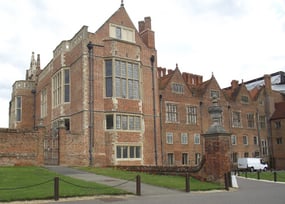We’re on LinkedIn!
Connect with WCS Environmental Engineering Safe Efficient Compliance

National Policing Improvement Agency (NPIA) required a new sewage treatment plant. Due to an increase in student numbers and tighter consent standards set by the Environment Agency, the existing plant was too small to cope with forecasted flows and loads.
The existing treatment plant consisted of a 150PE Rotating Biological Contactor (RBC) unit and a 450PE Submerged Aerated Filter (SAF) package plant. With an average student population of 1,100 and strict discharge limits of BOD 10mg/l; TSS 10mg/l and NH4-N 2mg/l, the plant needed to be upgraded.
The training college is a Grade 1 listed Jacobean mansion, set within rolling parkland on a beautiful 3,000 acre estate in Hampshire. The design of the sewage treatment plant had to be sympathetic to landscape and therefore was to be below ground with ancillaries not exceeding 1.5m.
The solution was a large four stage modular HiPAF (SAF biozone) sewage treatment plant. Flow is pumped from a balance tank into a 6m conical primary tank, where significant BOD and solids are removed. Settled sludge is removed by airlift to a Robust Aerobic Digestion unit, where sludge volumes are reduced by a minimum of 75%.
After primary settlement, settled liquor flows by gravity through a flow split chamber, where flow is split into two equal streams arranged in parallel. Each stream comprises two Submerged Aerated Filters (SAF) arranged in series. In these units carbonaceous and nitrifying processes take place and treated liquor flows by gravity into a final settlement Lamella plate clarifier. The final settlement removes biomass which is the by-product of the aeration process, before flowing by gravity to tertiary Sand Filters for final effluent polishing.
The sewage treatment plant is controlled by a Form 4 Motor Control Centre (MCC) which is housed in an existing building along with two rotary lobe type blowers. The blowers run duty/stand-by, providing emergency cover should one blower fail, with the added benefit that the blowers have a prolonged life cycle.
Frequency inverters were added to optimise the provision of scour air and reduce power consumption by an estimated 30%.
With nutrient neutrality requirements being enforced at off-mains properties in areas of England, homeowners need to ...
Why managing variable loads matters If you have an off mains wastewater treatment system operating at a hospitality, ...
Trade effluents are liquid waste streams discharged into public sewers from businesses and industrial processes. Their ...
Connect with WCS Environmental Engineering Safe Efficient Compliance
WCS Group is a trading name for WCS Environmental Ltd, registered in England and Wales (Number 02184649) at 20 Grosvenor Place, London, SW1X 7HN. Head Office – 17 Wheatstone Court, Waterwells Business Park, Gloucester, GL2 2AQ. WCS Group is a Marlowe Critical Services Company owned by Marlowe plc. 2025© WCS Environmental Ltd.